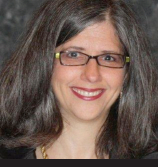
In the following interview, we speak with Dr. Carolyn Stern, MD, a Deaf family physician/urgent care physician, public speaker and disability advocate, cofounder of deafdoc.org, and medical director and school physician at the Rochester School for the Deaf. She is also a consultant for many organizations, including the National Board of Medical Examiners, National Association for the Deaf, National Center for Deaf Health Research, and World Federation of the Deaf.
Q. As a Deaf person, how did you get through school? How do you get through work every day?
Flexibility and a sense of humor are definitely important! Each situation is different, so mine is not a one-size-fits-all response. I usually use different methods to achieve the “best possible” result—a combination of environmental adaptations (room lighting and acoustics, for example), thinking outside the box, experimenting with different technologies, and working with support services. More often than not, talking with people helps a great deal. It also helps to be nice.
Q. What were you worried about when you finally finished your medical training?
As a Deaf physician, I was somewhat worried about how patients would react to me. I need not have worried! People tell me that they love the fact that I have to look at them—technology often distances people from each other. I have heard from many patients that their doctor never looks at them—they seem to pay more attention to the computer and the patient’s chart.
Q. What should I keep in mind when working with someone who is Deaf/Hard of Hearing?
There is a well-known short narrative, Welcome to Holland, by Emily Perl Kingsley. It is a metaphoric story about what it is like to have a child with a disability, or work with someone who has a disability. The premise: you planned all your life to travel to Italy, but when the plane lands, you end up in Holland. Now, you need to learn a new language, culture, and learn about available resources for your stay in Holland.
Throughout my own life experiences and the practice of medicine, I have found that only one thing is certain: there is no one single communication approach that works for all people. Any organization or person that claims that their method is the “only way” must realize that what worked with one person may not work for another.
The most important thing you can do is to ask them what works. If you can mutually work something out, great! If you can’t, work on it until it does—you both will benefit.
Q. What are some common myths about the Deaf and Hard of Hearing?
If I start to talk, the first response that people have toward me is, ‘Wow! You speak so well—how can you drive? Talk on the phone? Use a stethoscope?’ Any number of questions will follow.
My answer to them is yes, Deaf people can drive! They can “talk” or, better, communicate on the phone easily, and they can utilize stethoscopes and other visual devices as well.






